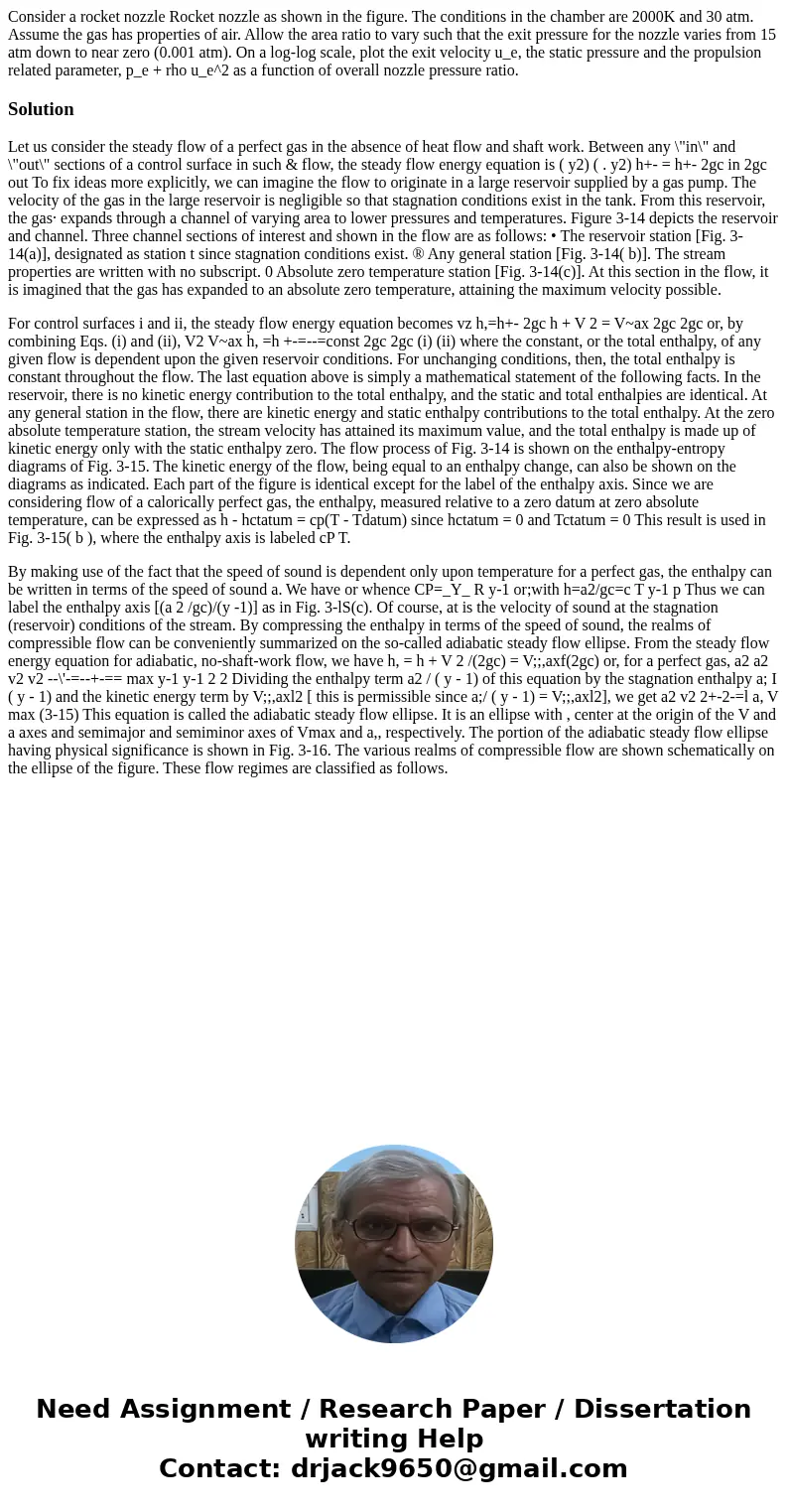Consider a rocket nozzle Rocket nozzle as shown in the figur
Solution
Let us consider the steady flow of a perfect gas in the absence of heat flow and shaft work. Between any \"in\" and \"out\" sections of a control surface in such & flow, the steady flow energy equation is ( y2) ( . y2) h+- = h+- 2gc in 2gc out To fix ideas more explicitly, we can imagine the flow to originate in a large reservoir supplied by a gas pump. The velocity of the gas in the large reservoir is negligible so that stagnation conditions exist in the tank. From this reservoir, the gas· expands through a channel of varying area to lower pressures and temperatures. Figure 3-14 depicts the reservoir and channel. Three channel sections of interest and shown in the flow are as follows: • The reservoir station [Fig. 3-14(a)], designated as station t since stagnation conditions exist. ® Any general station [Fig. 3-14( b)]. The stream properties are written with no subscript. 0 Absolute zero temperature station [Fig. 3-14(c)]. At this section in the flow, it is imagined that the gas has expanded to an absolute zero temperature, attaining the maximum velocity possible.
For control surfaces i and ii, the steady flow energy equation becomes vz h,=h+- 2gc h + V 2 = V~ax 2gc 2gc or, by combining Eqs. (i) and (ii), V2 V~ax h, =h +-=--=const 2gc 2gc (i) (ii) where the constant, or the total enthalpy, of any given flow is dependent upon the given reservoir conditions. For unchanging conditions, then, the total enthalpy is constant throughout the flow. The last equation above is simply a mathematical statement of the following facts. In the reservoir, there is no kinetic energy contribution to the total enthalpy, and the static and total enthalpies are identical. At any general station in the flow, there are kinetic energy and static enthalpy contributions to the total enthalpy. At the zero absolute temperature station, the stream velocity has attained its maximum value, and the total enthalpy is made up of kinetic energy only with the static enthalpy zero. The flow process of Fig. 3-14 is shown on the enthalpy-entropy diagrams of Fig. 3-15. The kinetic energy of the flow, being equal to an enthalpy change, can also be shown on the diagrams as indicated. Each part of the figure is identical except for the label of the enthalpy axis. Since we are considering flow of a calorically perfect gas, the enthalpy, measured relative to a zero datum at zero absolute temperature, can be expressed as h - hctatum = cp(T - Tdatum) since hctatum = 0 and Tctatum = 0 This result is used in Fig. 3-15( b ), where the enthalpy axis is labeled cP T.
By making use of the fact that the speed of sound is dependent only upon temperature for a perfect gas, the enthalpy can be written in terms of the speed of sound a. We have or whence CP=_Y_ R y-1 or;with h=a2/gc=c T y-1 p Thus we can label the enthalpy axis [(a 2 /gc)/(y -1)] as in Fig. 3-lS(c). Of course, at is the velocity of sound at the stagnation (reservoir) conditions of the stream. By compressing the enthalpy in terms of the speed of sound, the realms of compressible flow can be conveniently summarized on the so-called adiabatic steady flow ellipse. From the steady flow energy equation for adiabatic, no-shaft-work flow, we have h, = h + V 2 /(2gc) = V;;,axf(2gc) or, for a perfect gas, a2 a2 v2 v2 --\'-=--+-== max y-1 y-1 2 2 Dividing the enthalpy term a2 / ( y - 1) of this equation by the stagnation enthalpy a; I ( y - 1) and the kinetic energy term by V;;,axl2 [ this is permissible since a;/ ( y - 1) = V;;,axl2], we get a2 v2 2+-2-=l a, V max (3-15) This equation is called the adiabatic steady flow ellipse. It is an ellipse with , center at the origin of the V and a axes and semimajor and semiminor axes of Vmax and a,, respectively. The portion of the adiabatic steady flow ellipse having physical significance is shown in Fig. 3-16. The various realms of compressible flow are shown schematically on the ellipse of the figure. These flow regimes are classified as follows.

 Homework Sourse
Homework Sourse